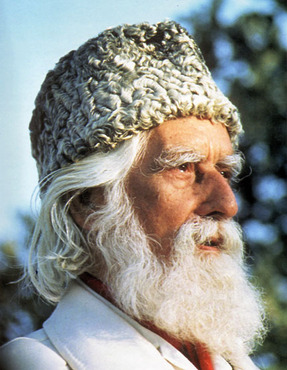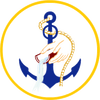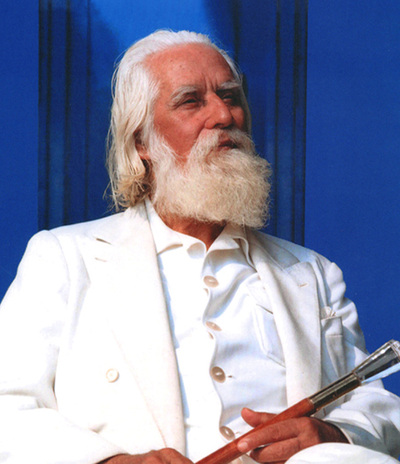 Omraam Mikhaël Aïvanhov at sunrise
Omraam Mikhaël Aïvanhov at sunrise
OMRAAM MIKHAËL AÏVANHOV
The Master Omraam Mikhaël Aïvanhov was born on 31 January 1900 into a poor family in the mountain village of Serbtzi in Macedonia. His father travelled across Bulgaria to Varna on the Black Sea to make a living, and Mikhaël and his siblings were brought up by their mother and the extended family, which included his grandmother (a midwife and healer), to whom he was especially close.
What Mikhaël called his ‘childhood passions’ were significant: fire, coloured threads, water gushing from a spring, birds and climbing tall trees. All these later came to represent spiritual truths for him.
At the age of seven, Mikhaël saw his village torched to the ground by soldiers, and he and his family made the long journey to Varna to join his father, who died less than two years later. From this time the family lived in extreme poverty, and Mikhaël was obliged to work from an early age, first for a blacksmith and then in many other trades.
As a teenager Mikhaël had a very strong spiritual nature and was a voracious reader of Bulgarian translations of spiritual books. He began to practise meditation, fasting and breathing exercises, among other things, and at sixteen experienced his first spiritual awakening, during which he heard the music of the spheres. In 1917 he met the Master Peter Deunov in Varna and became his disciple. Mikhaël loved music and his violin was one given him by his master.
After his university studies in Sofia, Mikhaël became a college teacher and, in 1934, a college director. At the same time he steadfastly followed the teaching of Peter Deunov, which was a field of profound exploration and experiences.
In 1937, faced with the rising threat of communism, Peter Deunov sent Mikhaël to France to spread his spiritual teaching. Mikhaël quickly learned French and began giving lectures at Sèvres, near Paris. In common with other spiritual initiates, he underwent periods of profound suffering but through the power of his spirit he was able to transform these experiences into what he called ‘precious stones’.
Over the course of almost 50 years, he gave thousands of free public lectures and private interviews, initially in Paris and later at the main centre of the Fraternité Blanche Universelle (known in English as the Universal White Brotherhood) at the Bonfin near Fréjus in the south of France.
In 1959, Brother Mikhaël, as he was still known, made his first trip to India where he met Neem Karoli Babaji. He was given the spiritual name Omraam after undergoing a profound spiritual and physical transformation. On his return to France his disciples noted the striking resemblance to Peter Deunov and were spontaneously moved to call him ‘Master’.
As well as continuing to teach at the Bonfin, he also travelled all over the world giving talks and visiting spiritual sites. As a man and a teacher, he was seen to be a true master of himself, manifesting the presence of the divine world, and his talks were full of wisdom, love, vitality, humour and integrity.
By the time of his death in 1986, Omraam Mikhaël Aivanhov’s teaching had a following of thousands throughout the world. It has since spread to every continent, and his lectures have been translated into 32 languages. Many followers visit the Bonfin each year to do collective spiritual work, and there are several centres and groups worldwide who practise the spiritual methods he taught.
To find out more about the extraordinary life and work of Omraam Mikhaël Aïvanhov, we recommend you read ‘Omraam Mikhael Aivanhov – a biography’ by Louise-Marie Frenette.
The name Omraam
“This name, says Georg Feuerstein, is made up of two famous Sanskrit mantras or words of power, Om and Ram.
Om is the most sacred mantra of the Hindus. It stands for the Absolute, or Divine itself.
The syllable Ram, which was rendered as "Raam" in French to assist with the correct pronunciation, is the mantra denoting the fire element.
The Master explained his initiatic name as follows:
"Thus the name I was given in India, OMRAAM, corresponds to the two processes of ‘Solve’ and ‘Coagula’: OM dissolves all things, rendering them suble and fine, and Raam materializes them. The name OMRAAM is the symbol of the process of concretization, the invisible, intangible idea that must incarnate on earth so that it can be seen and touched by the whole world."
All this time, Brother Mikhaël had refused to be addressed as master by his disciples. He had always regarded himself as their fellow-disciple of his own teacher, Peter Deunov. Now everything was changed. His disciples, who had been following him for 22 years, insisted on paying him due respect, and he finally accepted being called ‘Master’.
“A true master, he explained, is one who knows the truth, is thoroughly familiar with and upholds the laws and principles of existence. He also has the will and ability to control his inner environment and to use this ability only in order to ‘manifest all the qualities and virtues of unselfish love.’
“Disinterestedness is unselfish love, which, for Aivanhov, finds its highest expression in the known universe in the sun.
“He also said: ‘The ideal of a disciple is to free himself from all restrictions, to throw off everything that hampers him, and become like light’
“The restrictions Aivanhov had in mind are the boundaries erected by the ego-personality, which make it virtually impossible for the ordinary person to see things as they really are and to think, feel, and act in consonance with Reality.”
Georg Feuerstein
“The Mystery of Light” Passage Press
The Master Omraam Mikhaël Aïvanhov was born on 31 January 1900 into a poor family in the mountain village of Serbtzi in Macedonia. His father travelled across Bulgaria to Varna on the Black Sea to make a living, and Mikhaël and his siblings were brought up by their mother and the extended family, which included his grandmother (a midwife and healer), to whom he was especially close.
What Mikhaël called his ‘childhood passions’ were significant: fire, coloured threads, water gushing from a spring, birds and climbing tall trees. All these later came to represent spiritual truths for him.
At the age of seven, Mikhaël saw his village torched to the ground by soldiers, and he and his family made the long journey to Varna to join his father, who died less than two years later. From this time the family lived in extreme poverty, and Mikhaël was obliged to work from an early age, first for a blacksmith and then in many other trades.
As a teenager Mikhaël had a very strong spiritual nature and was a voracious reader of Bulgarian translations of spiritual books. He began to practise meditation, fasting and breathing exercises, among other things, and at sixteen experienced his first spiritual awakening, during which he heard the music of the spheres. In 1917 he met the Master Peter Deunov in Varna and became his disciple. Mikhaël loved music and his violin was one given him by his master.
After his university studies in Sofia, Mikhaël became a college teacher and, in 1934, a college director. At the same time he steadfastly followed the teaching of Peter Deunov, which was a field of profound exploration and experiences.
In 1937, faced with the rising threat of communism, Peter Deunov sent Mikhaël to France to spread his spiritual teaching. Mikhaël quickly learned French and began giving lectures at Sèvres, near Paris. In common with other spiritual initiates, he underwent periods of profound suffering but through the power of his spirit he was able to transform these experiences into what he called ‘precious stones’.
Over the course of almost 50 years, he gave thousands of free public lectures and private interviews, initially in Paris and later at the main centre of the Fraternité Blanche Universelle (known in English as the Universal White Brotherhood) at the Bonfin near Fréjus in the south of France.
In 1959, Brother Mikhaël, as he was still known, made his first trip to India where he met Neem Karoli Babaji. He was given the spiritual name Omraam after undergoing a profound spiritual and physical transformation. On his return to France his disciples noted the striking resemblance to Peter Deunov and were spontaneously moved to call him ‘Master’.
As well as continuing to teach at the Bonfin, he also travelled all over the world giving talks and visiting spiritual sites. As a man and a teacher, he was seen to be a true master of himself, manifesting the presence of the divine world, and his talks were full of wisdom, love, vitality, humour and integrity.
By the time of his death in 1986, Omraam Mikhaël Aivanhov’s teaching had a following of thousands throughout the world. It has since spread to every continent, and his lectures have been translated into 32 languages. Many followers visit the Bonfin each year to do collective spiritual work, and there are several centres and groups worldwide who practise the spiritual methods he taught.
To find out more about the extraordinary life and work of Omraam Mikhaël Aïvanhov, we recommend you read ‘Omraam Mikhael Aivanhov – a biography’ by Louise-Marie Frenette.
The name Omraam
“This name, says Georg Feuerstein, is made up of two famous Sanskrit mantras or words of power, Om and Ram.
Om is the most sacred mantra of the Hindus. It stands for the Absolute, or Divine itself.
The syllable Ram, which was rendered as "Raam" in French to assist with the correct pronunciation, is the mantra denoting the fire element.
The Master explained his initiatic name as follows:
"Thus the name I was given in India, OMRAAM, corresponds to the two processes of ‘Solve’ and ‘Coagula’: OM dissolves all things, rendering them suble and fine, and Raam materializes them. The name OMRAAM is the symbol of the process of concretization, the invisible, intangible idea that must incarnate on earth so that it can be seen and touched by the whole world."
All this time, Brother Mikhaël had refused to be addressed as master by his disciples. He had always regarded himself as their fellow-disciple of his own teacher, Peter Deunov. Now everything was changed. His disciples, who had been following him for 22 years, insisted on paying him due respect, and he finally accepted being called ‘Master’.
“A true master, he explained, is one who knows the truth, is thoroughly familiar with and upholds the laws and principles of existence. He also has the will and ability to control his inner environment and to use this ability only in order to ‘manifest all the qualities and virtues of unselfish love.’
“Disinterestedness is unselfish love, which, for Aivanhov, finds its highest expression in the known universe in the sun.
“He also said: ‘The ideal of a disciple is to free himself from all restrictions, to throw off everything that hampers him, and become like light’
“The restrictions Aivanhov had in mind are the boundaries erected by the ego-personality, which make it virtually impossible for the ordinary person to see things as they really are and to think, feel, and act in consonance with Reality.”
Georg Feuerstein
“The Mystery of Light” Passage Press





